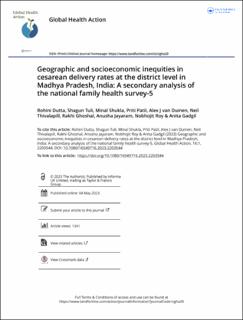| dc.contributor.author | Dutta, Rohini | |
| dc.contributor.author | Tuli, Shagun | |
| dc.contributor.author | Shukla, Minal | |
| dc.contributor.author | Patil, Priti | |
| dc.contributor.author | van Duinen, Aalke Johan | |
| dc.contributor.author | Thivalapill, Neil | |
| dc.contributor.author | Ghoshal, Rakhi | |
| dc.contributor.author | Jayaram, Anusha | |
| dc.contributor.author | Roy, Nobhojit | |
| dc.contributor.author | Gadgil, Anita | |
| dc.date.accessioned | 2023-11-17T13:46:22Z | |
| dc.date.available | 2023-11-17T13:46:22Z | |
| dc.date.created | 2023-06-02T12:40:06Z | |
| dc.date.issued | 2023 | |
| dc.identifier.citation | Global health action. 2023, 16, 2203544 | en_US |
| dc.identifier.issn | 1654-9716 | |
| dc.identifier.uri | https://hdl.handle.net/11250/3103295 | |
| dc.description.abstract | Background
In India, caesarean delivery (CD) accounts for 17% of the births, of which 41% occur in private facilities. However, areas to CD in rural areas are limited, particularly for the poor populations. Little information is available on state-wise district-level CD rates by geography and the population wealth quintiles, especially in Madhya Pradesh (MP), the fifth most populous and third poorest state.
Objective
Investigate geographic and socioeconomic inequities of CD across the 51 districts in MP and compare the contribution of public and private healthcare facilities to the overall state CD rate.
Methods
This cross-sectional study utilised the summary fact sheets of the National Family Health Survey (NFHS)-5 performed from January 2019 to April 2021. Women aged 15 to 49 years, with live births two years preceding the survey were included. District-level CD rates in MP were used to determine the inequalities in accessing CD in the poorer and poorest wealth quintiles. CD rates were stratified as <10%, 10–20% and >20% to measure equity of access. A linear regression model was used to examine the correlation between the fractions of the population in the two bottom wealth quintiles and CD rates.
Results
Eighteen districts had a CD rate below 10%, 32 districts were within the 10%–20% threshold and four had a rate of 20% or higher. Districts with a higher proportion of poorer population and were at a distance from the capital city Bhopal were associated with lower CD rates. However, this decline was steeper for private healthcare facilities (R2 = 0.382) revealing a possible dependency of the poor populations on public healthcare facilities (R2 = 0.009) for accessing CD.
Conclusion
Although CD rates have increased across MP, inequities within districts and wealth quintiles exist, warranting closer attention to the outreach of government policies and the need to incentivise CDs where underuse is significant. | en_US |
| dc.language.iso | eng | en_US |
| dc.publisher | Taylor & Francis | en_US |
| dc.rights | Navngivelse 4.0 Internasjonal | * |
| dc.rights.uri | http://creativecommons.org/licenses/by/4.0/deed.no | * |
| dc.title | Geographic and socioeconomic inequities in cesarean delivery rates at the district level in Madhya Pradesh, India: A secondary analysis of the national family health survey-5 | en_US |
| dc.title.alternative | Geographic and socioeconomic inequities in cesarean delivery rates at the district level in Madhya Pradesh, India: A secondary analysis of the national family health survey-5 | en_US |
| dc.type | Peer reviewed | en_US |
| dc.type | Journal article | en_US |
| dc.description.version | publishedVersion | en_US |
| dc.source.volume | 16 | en_US |
| dc.source.journal | Global health action | en_US |
| dc.identifier.doi | 10.1080/16549716.2023.2203544 | |
| dc.identifier.cristin | 2151187 | |
| dc.source.articlenumber | 2203544 | en_US |
| cristin.ispublished | true | |
| cristin.fulltext | original | |
| cristin.qualitycode | 1 | |

